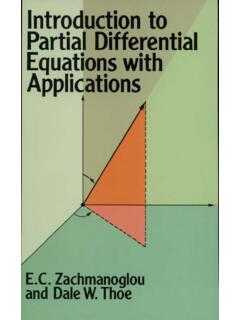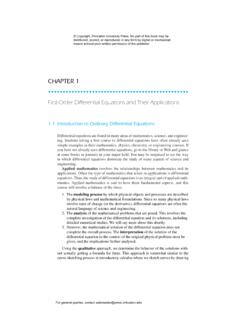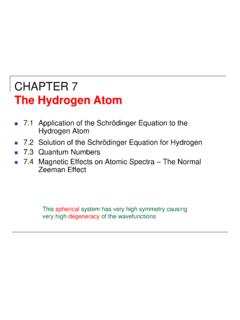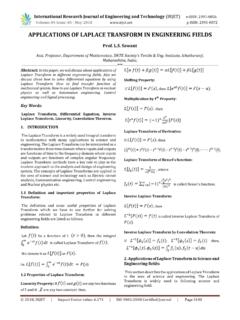Transcription of SYLLABUS for JEE (Main)-2021 Syllabus for Paper-1 (B.E./B ...
1 SYLLABUS for JEE (Main)-2021 SYLLABUS for Paper-1 ( )- Mathematics, Physics and Chemistry MATHEMATICS UNIT 1: SETS, RELATIONS AND FUNCTIONS: Sets and their representation: Union, intersection and complement of sets and their algebraic properties; Power set; Relation, Type of relations, equivalence relations, functions; one-one, into and onto functions, the composition of functions. UNIT 2: COMPLEX NUMBERS AND QUADRATIC equations : Complex numbers as ordered pairs of reals, Representation of complex numbers in the form a + ib and their representation in a plane, Argand diagram, algebra of complex number, modulus and argument (or amplitude) of a complex number, square root of a complex number, triangle inequality, Quadratic equations in real and complex number system and their solutions Relations between roots and co-efficient, nature of roots, the formation of quadratic equations with given roots.
2 UNIT 3: MATRICES AND DETERMINANTS: Matrices, algebra of matrices, type of matrices, determinants and matrices of order two and three, properties of determinants, evaluation of determinants, area of triangles using determinants, Adjoint and evaluation of inverse of a square matrix using determinants and elementary transformations, Test of consistency and solution of simultaneous linear equations in two or three variables using determinants and matrices. UNIT 4: PERMUTATIONS AND COMBINATIONS: The fundamental principle of counting, permutation as an arrangement and combination as section, Meaning of P (n,r) and C (n,r), simple applications. UNIT 5: MATHEMATICAL INDUCTIONS: Principle of Mathematical Induction and its simple applications. UNIT 6: BINOMIAL THEOREM AND ITS SIMPLE APPLICATIONS: Binomial theorem for a positive integral index, general term and middle term, properties of Binomial coefficients and simple applications.
3 UNIT 7: SEQUENCE AND SERIES: Arithmetic and Geometric progressions, insertion of arithmetic, geometric means between two given numbers, Relation between and sum up to n terms of special series; Sn, Sn2, Sn3. Arithmetico-Geometric progression. UNIT 8: LIMIT, CONTINUITY AND DIFFERENTIABILITY: Real valued functions, algebra of functions, polynomials, rational, trigonometric, logarithmic and exponential functions, inverse function. Graphs of simple functions. Limits, continuity and differentiability. Differentiation of the sum, difference, product and quotient of two functions. Differentiation of trigonometric, inverse trigonometric, logarithmic, exponential, composite and implicit functions; derivatives of order up to two, Rolle s and Lagrange's Mean value Theorems, Applications of derivatives: Rate of change of quantities, monotonic-Increasing and decreasing functions, Maxima and minima of functions of one variable, tangents and normal.
4 UNIT 9: INTEGRAL CALCULAS: Integral as an anti-derivative, Fundamental Integrals involving algebraic, trigonometric, exponential and logarithms functions. Integrations by substitution, by parts and by partial functions. Integration using trigonometric identities. Evaluation of simple integrals of the type 2+ 2 , 2 2 , 2 2 , 2 2 , 2+ + , 2+ + , ( + ) 2+ + , ( + ) 2+ + 2 2 , 2 2 Integral as limit of a sum. The fundamental theorem of calculus, properties of definite integrals. Evaluation of definite integrals, determining areas of the regions bounded by simple curves in standard form. UNIT 10: DIFFRENTIAL equations Ordinary differential equations , their order and degree, the formation of differential equations , solution of differential equation by the method of separation of variables, solution of a homogeneous and linear differential equation of the type + ( ) = ( ) UNIT 11: CO-ORDINATE GEOMETRY Cartesian system of rectangular co-ordinates in a plane, distance formula, sections formula, locus and its equation, translation of axes, the slope of a line, parallel and perpendicular lines, intercepts of a line on the co-ordinate axis.
5 Straight line Various forms of equations of a line, intersection of lines, angles between two lines, conditions for concurrence of three lines, the distance of a point form a line, equations of internal and external by sectors of angles between two lines co-ordinate of the centroid, orthocentre and circumcentre of a triangle, equation of the family of lines passing through the point of intersection of two lines. Circle, conic sections A standard form of equations of a circle, the general form of the equation of a circle, its radius and central, equation of a circle when the endpoints of a diameter are given, points of intersection of a line and a circle with the centre at the origin and condition for a line to be tangent to a circle, equation of the tangent, sections of conics, equations of conic sections (parabola, ellipse and hyperbola) in standard forms, condition for Y = mx +c to be a tangent and point (s) of tangency.
6 UNIT 12: THREE DIMENSIONAL GEOMETRY Coordinates of a point in space, the distance between two points, section formula, directions ratios and direction cosines, the angle between two intersecting lines. Skew lines, the shortest distance between them and its equation. equations of a line and a plane in different forms, the intersection of a line and a plane, coplanar lines. UNIT 13: VECTOR ALGEBRA Vectors and scalars, the addition of vectors, components of a vector in two dimensions and three-dimensional space, scalar and vector products, scalar and vector triple product. UNIT 14: STATISTICS AND PROBABILITY Measures of discretion; calculation of mean, median, mode of grouped and ungrouped data calculation of standard deviation, variance and mean deviation for grouped and ungrouped data. Probability: Probability of an event, addition and multiplication theorems of probability, Baye's theorem, probability distribution of a random variate, Bernoulli trials and binomial distribution.
7 UNIT 15: TRIGONOMETRY Trigonometrical identities and equations , trigonometrical functions, inverse trigonometrical functions and their properties, heights and distance. UNIT 16: MATHEMATICAL REASONING Statement logical operations and, or, implies, implied by, if and only if, understanding of tautology, contradiction, converse and contrapositive. PHYSICS The SYLLABUS contains two Section- A and B, Section A pertains to the Theory Part having 80% weightage, while Sections B contains practical component (Experimental Skills) having 20 % Weightage. Section- A UNIT 1: PHYSICS AND MEASUREMENT Physics, technology and society, S I Units, fundamental and derived units, least count, accuracy and precision of measuring instruments, Errors in measurement, Dimensions of Physics quantities, dimensional analysis and its applications. UNIT 2: KINEMATICS The frame of reference, motion in a straight line, Position- time graph, speed and velocity; Uniform and non-uniform motion, average speed and instantaneous velocity, uniformly accelerated motion, velocity-time, position-time graph, relations for uniformly accelerated motion, Scalars and Vectors, Vector.
8 Addition and subtraction, zero vector, scalar and vector products, Unit Vector, Resolution of a Vector. Relative Velocity, Motion in a plane, Projectile Motion, Uniform Circular Motion. UNIT 3: LAWS OF MOTION Force and inertia, Newton s First law of motion; Momentum, Newton s Second Law of motion, Impulses; Newton s Third Law of motion. Law of conservation of linear momentum and its applications. Equilibrium of concurrent forces. Static and Kinetic friction, laws of friction, rolling friction. Dynamics of uniform circular motion: centripetal force and its applications. UNIT 4: WORK, ENERGY AND POWER Work done by a content force and a variable force; kinetic and potential energies, work-energy theorem, power. The potential energy of spring conservation of mechanical energy, conservative and neoconservative forces; Elastic and inelastic collisions in one and two dimensions.
9 UNIT5: ROTATIONAL MOTION Centre of the mass of a two-particle system, Centre of the mass of a rigid body; Basic concepts of rotational motion; a moment of a force; torque, angular momentum, conservation of angular momentum and its applications; the moment of inertia, the radius of gyration. Values of moments of inertia for simple geometrical objects, parallel and perpendicular axes theorems and their applications. Rigid body rotation equations of rotational motion. UNIT 6: GRAVITATION The universal law of gravitation. Acceleration due to gravity and its variation with altitude and depth. Kepler s law of planetary motion. Gravitational potential energy; gravitational potential. Escape velocity, Orbital velocity of a satellite. Geo stationary satellites. UNIT 7: PROPERTIES OF SOLIDS AND LIQUIDS Elastic behaviour, Stress-strain relationship, Hooke's Law.
10 Young's modulus, bulk modulus, modulus of rigidity. Pressure due to a fluid column; Pascal's law and its applications. Viscosity. Stokes' law. terminal velocity, streamline and turbulent flow. Reynolds number. Bernoulli's principle and its applications. Surface energy and surface tension, angle of contact, application of surface tension - drops, bubbles and capillary rise. Heat, temperature, thermal expansion; specific heat capacity, calorimetry; change of state, latent heat. Heat transfer-conduction, convection and radiation. Newton's law of cooling. UNIT 8: THERMODYNAMICS Thermal equilibrium, zeroth law of thermodynamics, the concept of temperature. Heat, work and internal energy. The first law of thermodynamics. The second law of thermodynamics: reversible and irreversible processes. Carnot engine and its efficiency.

















